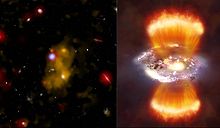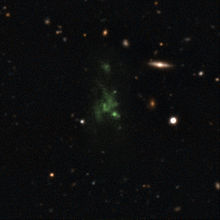
In astronomy, a Lyman-alpha blob (LAB) is a huge concentration of a gas emitting the Lyman-alpha emission line. LABs are some of the largest known individual objects in the Universe. Some of these gaseous structures are more than 400,000 light years across. So far they have only been found in the high-redshift universe because of the ultraviolet nature of the Lyman-alpha emission line. Since Earth's atmosphere is very effective at filtering out UV photons, the Lyman-alpha photons must be redshifted in order to be transmitted through the atmosphere.
The most famous Lyman-alpha blobs were discovered in 2000 by Steidel et al.[1] Matsuda et al., using the Subaru Telescope of the National Astronomical Observatory of Japan extended the search for LABs[2] and found over 30 new LABs in the original field of Steidel et al.,[1] although they were all smaller than the originals. These LABs form a structure which is more than 200 million light-years in extent. It is currently unknown whether LABs trace overdensities of galaxies in the high-redshift universe (as high redshift radio galaxies—which also have extended Lyman-alpha halos—do, for example), nor which mechanism produces the Lyman-alpha emission line, or how the LABs are connected to the surrounding galaxies. Lyman-alpha blobs may hold valuable clues to determine how galaxies are formed.
The most massive Lyman-alpha blobs have been discovered by Tristan Friedrich et al. (2021),[citation needed] Steidel et al. (2000),[1] Francis et al. (2001),[3] Matsuda et al. (2004),[4] Dey et al. (2005),[5] Nilsson et al. (2006),[6] and Smith & Jarvis et al. (2007).[7]
Examples

- Himiko
- LAB-1[8]
- EQ J221734.0+001701, the SSA22 Protocluster
- Ton 618, hyperluminous quasar powering a Lyman-alpha blob; also possesses one of the most massive black holes known.
See also
- Damped Lyman-alpha system
- Galaxy filament
- Green bean galaxy
- Lyman-alpha forest
- Lyman-alpha emitter
- Lyman break galaxy
- Newfound Blob (disambiguation)
Notes
- ^ a b c Steidel, C. C.; Adelberger, K. L.; Shapley, A. E. (2000). "Lyα Imaging of a Proto–Cluster Region at ⟨ z ⟩ = 3.09". Astrophysical Journal. 532 (1): 170–82. arXiv:astro-ph/9910144. Bibcode:2000ApJ...532..170S. doi:10.1086/308568. S2CID 10353723.
- ^ "Giant gas clouds illuminate universe's largest structure" (Press release). Subaru Telescope, National Astronomical Observatory of Japan. 26 July 2006. Retrieved 3 April 2019.
- ^ Francis; et al. (2001). "A Pair of Compact Red Galaxies at Redshift 2.38, Immersed in a 100 kpc Scale Ly-alpha Nebula". The Astrophysical Journal. 554 (2): 1001. arXiv:astro-ph/0102263. Bibcode:2001ApJ...554.1001F. doi:10.1086/321417. S2CID 119507680.
- ^ Matsuda; et al. (2004). "A Subaru Search for Ly-alpha Blobs in and around the Proto-cluster Region at Redshift z=3.1". The Astronomical Journal. 128 (2): 569–584. arXiv:astro-ph/0405221. Bibcode:2004AJ....128..569M. doi:10.1086/422020. S2CID 11242891.
- ^ Dey; et al. (2005). "Discovery of a Large ~200 kpc Gaseous Nebula at z=2.7 with the Spitzer Space Telescope". The Astrophysical Journal. 629 (2): 654–666. arXiv:astro-ph/0503632. Bibcode:2005ApJ...629..654D. doi:10.1086/430775. S2CID 16902543.
- ^ Nilsson; et al. (2006). "A Lyman-alpha blob in the GOODS South field: evidence for cold accretion onto a dark matter halo". Astronomy and Astrophysics Letters. 452 (3): L23 – L26. arXiv:astro-ph/0512396. Bibcode:2006A&A...452L..23N. doi:10.1051/0004-6361:200600025. S2CID 14837456.
- ^ Smith; et al. (2007). "Evidence for Cold Accretion onto a Massive Galaxy at High Redshift?". Monthly Notices of the Royal Astronomical Society Letters. 378 (1): L49 – L53. arXiv:astro-ph/0703522. Bibcode:2007MNRAS.378L..49S. doi:10.1111/j.1745-3933.2007.00318.x. S2CID 6656503.
- ^ "Giant Space Blob Glows from Within". ESO Press Release. 17 August 2011. Retrieved 18 August 2011.








